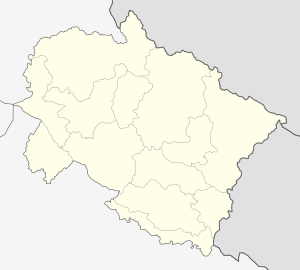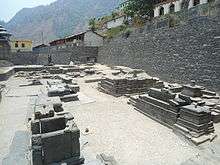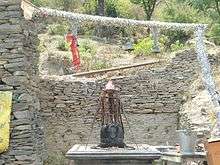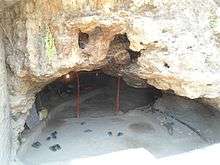Lakhamandal
| Lkhamandal Temple | |
|---|---|
 | |
 Lkhamandal Temple Location in Uttarakhand | |
| Name | |
| Other names | The name of village where the temple lies is called as Marda (मड़ा) in local Jaunsari dilect. |
| Proper name | Lakhamandal Temple |
| Geography | |
| Coordinates | 30°43′52″N 78°04′03″E / 30.731224°N 78.067423°ECoordinates: 30°43′52″N 78°04′03″E / 30.731224°N 78.067423°E |
| Country | India |
| State | Uttarakhand |
| District | Dehradun |
| Location | Lakhamandal, Dehradun district |
| Culture | |
| Primary deity | Lord Shiva |
| Important festivals | Jagra (jagran) |
| Architecture | |
| Architectural styles | Huna architecture |
Lakhamandal is an ancient Hindu temple complex, situated in the Jaunsar-Bawar region of Dehradun district in the state of Uttarakhand. The temple is dedicated to lord Shiva.[1] This temple is popular among the Shakti Cult, who believe that a visit to this temple shrine will end their misfortunes.
Lakhamandal gets its name from the two words: lakha (Lakh) meaning "many" and mandals meaning "temples" or "lingam". Plenty of artistic works were found in the excavations by the Archaeological Survey of India.[2]
Location
This temple lies 128 km. from Dehradun, and 35 km. from Chakrata on the Mussoorie-Yamnotri road, past Kempty Falls.[3] It is built in North Indian Architectural style, which is common in the hilly regions of Garhwal, Jaunsar and Himachal. The Yamuna River flows alongside Lakhamandal village where the temple is situated.
Lingam
The main attraction of this temple shrine is the graphite Lingam. It shines when wet and reflects its surroundings.
Legend and the cave
According to the local people, this temple and the adjoining area are believed to be where Duryodhana of Mahabharata episode conspired to burn alive the Pandava in the Lakshyagriha house, constructed with shellac.
Twin statues of Danav and Manav are located beside the main shrine. The statues are its dwarpals (doormen). Some people believe these statues to be those of Pandava brothers Bhima and Arjuna. They also resemble Jai and Vijay, the doormen of Lord Vishnu. When someone was dying or had just died, an appearance in front of these statues, returns them briefly to life before finally expiring. The power of Manav kept the person alive, while Danav took the person's soul to Lord Vishnu's abode.
Another cave near this place is called Dhundhi Odaari in the local Jaunsari language. Dhundi or Dhund means "misty" or "foggy" and odaar or odaari means "cave" or "hidden place". The local people think that the Pandava took refuge in this cave to save themselves from Duryodhana.
Gallery
 Mandals at Lakhamandal Temple. |
 Graphite Lingam at the Lakhamandal Temple. |
 Danav Manav. |
 The cave near the Lakhamandal Temple. |
References
- ↑ Madhu Jaina (1995). The Abode of Mahashiva: Cults and Symbology in Jaunsar-Bawar in the Mid-Himalayas. Indus Publishing. pp. 21–23–. ISBN 978-81-7387-030-9.
- ↑ "Archaeological Survey of India, Dehradun Circle". ASI website.
- ↑ "Lakhamandal". District of Dehradun, official website. Retrieved 2015-10-29.